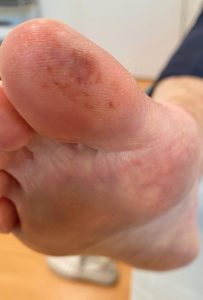
What are chilblains?
- Red, itchy, painful lesions, bumps or blisters that typically occur on the tips of your toes (but can also occur on fingers and noses)
- Common after exposure to cold temperatures and rapid temperature changes from cold to warmth
- Caused by a narrowing of blood vessels in cold weather followed by a rapid widening of the vessels when temperatures rise
- Small amounts of blood will leak into surrounding tissue, this is where the red or purple discolouration originates from
- Chilblains are more common in the very young, or the elderly who have poor circulation, and if left untreated may ulcerate.
How can you reduce the likelihood of chilblains?
- Prevention is better than cure – Temperature regulation is key therefore keeping warm is the best defence
What to do:
- Warm socks and shoes are very important, although don’t neglect your core temperature and layer up with jumpers and jackets
- The best socks to wear should be fully cotton or even better is wool or bamboo
- Exercise regularly, if you’re stuck at a desk or sedentary for large parts of the day give yourself 5 minutes every hour to wiggle your toes or get up and move about to keep your blood flowing
- One area to consider with the toes is going from a warm bed to a cold bathroom barefoot. Wear socks or slippers if possible, to avoid the sudden temperature change. When going into the shower, warm the water first and get the floor heated with the water before stepping in
What not to do:
- Avoid large and rapid fluctuations in temperature such as hot showers or baths soon after taking off wet, damp clothing and socks.
- Avoid extreme heat such as sitting with your feet in front of a heater or on a hot water bottle
- Avoid itching the area
Treatment:
- Symptoms such as itchiness or pain can be managed with different topical ointments and medications
- Special insoles to retain heat can be added to your shoes via your podiatrist
- In severe cases medication via the GP may be necessary
- If the skin is broken please seek immediate attention from your podiatrist – do not apply any ointments until advised on the correct course of action.
